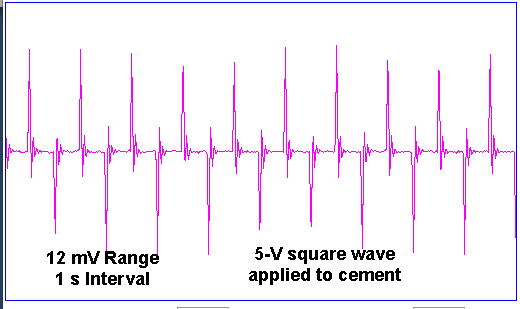
Figure: Lamp Flashing Artifact for First A3030D Implanted, D7.2. Archive M1439901477.ndf, 2352 s.
Last week we observed only the 200-μVpp artifact we expect from our tests at OSI. We consider the possibility that dental cement (acrylic and powder) mixed with water is conducting until the water evaporates. We mix up dental cement with and without adding a few drops of water. When we add water, we get drops of water coalescing outside the cement. (Methyl methacrylate is hydrophobic.) Resistance between two probes placed 0.5 mm apart is greater than 10 MΩ in all cases. We cement two wires 5 mm apart and plug the electrodes of a 10-MΩ amplifier into the cement near each wire, but not in contact with the wire.

Figure: Cement Noise Coupling Measurement. We use an A3028E with 10-MΩ input impedance to pick up a 5-V square wave applied to two wires embedded in the cement.
We bake our apparatus at 60°C to make sure it is dry. We apply a 5-V, 10-Hz square wave to the two wires and observe the following on the A3028E output.

Figure: Cement Voltage Coupling. We have 10-MΩ input impedance and a 5-V, 10-Hz square wave applied to the wires.
We cover both amplifier electrodes with a few drops of water. The impedance between the elecrodes is now 600 kΩ measured at 0 Hz. The coupled signal drops to less than 100 μVpp from 10 mVpp. We dry off, apply a 5-Vpp sinusoid, and obtain the following graph of coupled amplitude versus frequency. The slope of the graph suggests the coupling through the cement is capacitive.

Figure: Cement Voltage Coupling versus Frequency. The initial positive slope shows coupling increasing as f. After 160 Hz, the attenuition of the three-pole low-pass filter changes the response to 1/f2.
At 100 Hz, we get 0.1% of the applied sine wave at our amplifier input, which suggests that our 10-MΩ input impedance is 0.1% of the impedance of the coupling capacitance, so that this capacitance is of order 0.2 pF. The dielectric constant of this cement should be around 4, so 0.2 pF can be made with two 2-mm square plates separated by 1 mm. We cut the blue X− lead. The coupled noise remains the same. We cut the X+ lead. The noise drops from 10 mVpp to 100 μVpp.
Our cement does not conduct electricity, even when we add water during mixing. The input impedance of the A3030D amplifier is 100 kΩ. If both electrodes are connected to the brain, the impedance between them will be closer to 1 kΩ. In either case, the noise coupled from a 5-V square wave applied to the same lump of dental cement will be less than 100 μV. Even if we disconnect the X− and leave X attached, artifact will be less than 100 μV.
Conduction through dry or wet cement cannot explain the artifact we observed from D7.2 when it was first implanted. Capacitive coupling cannot explain the artifact either, becasue the A3030D has input impedance only 100 KΩ.
No comments:
Post a Comment